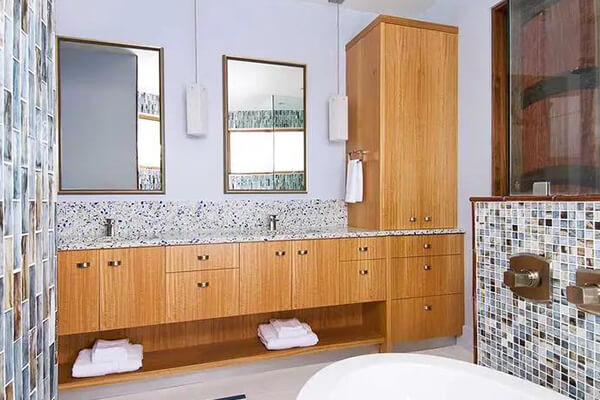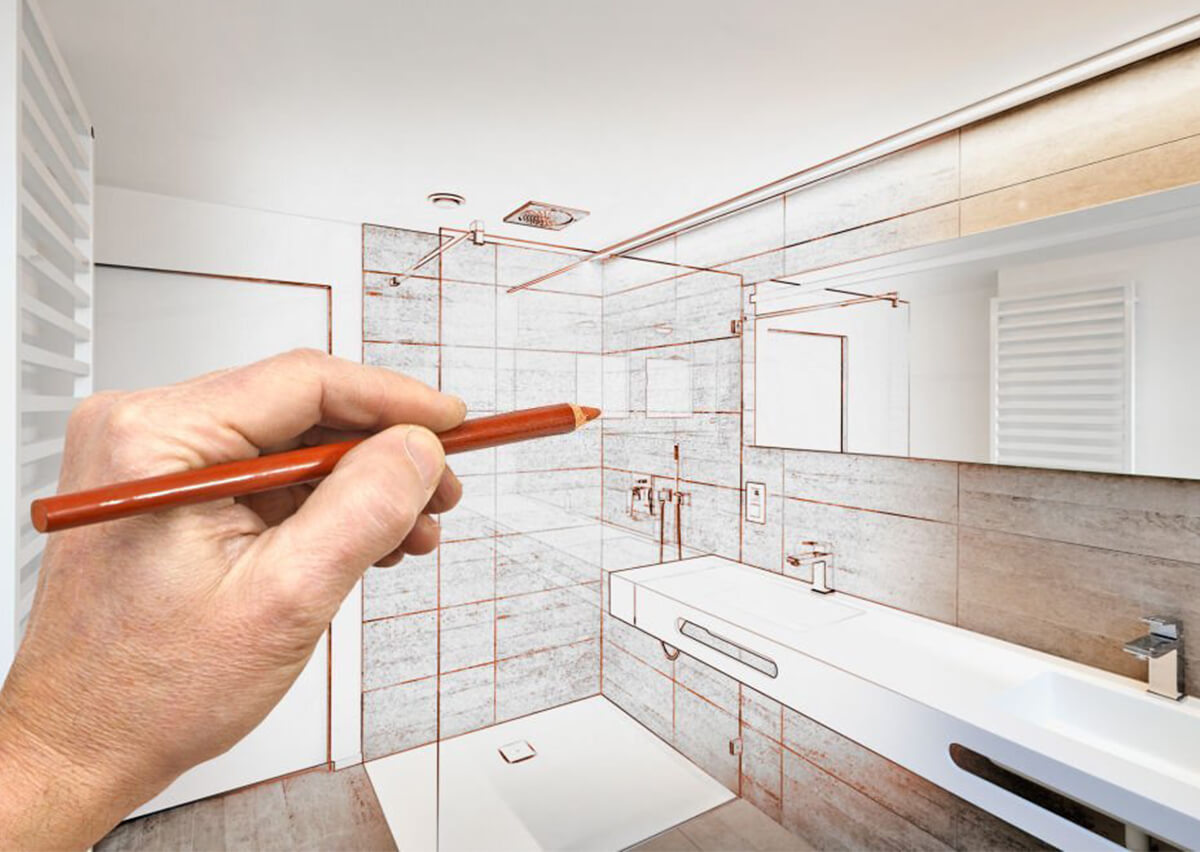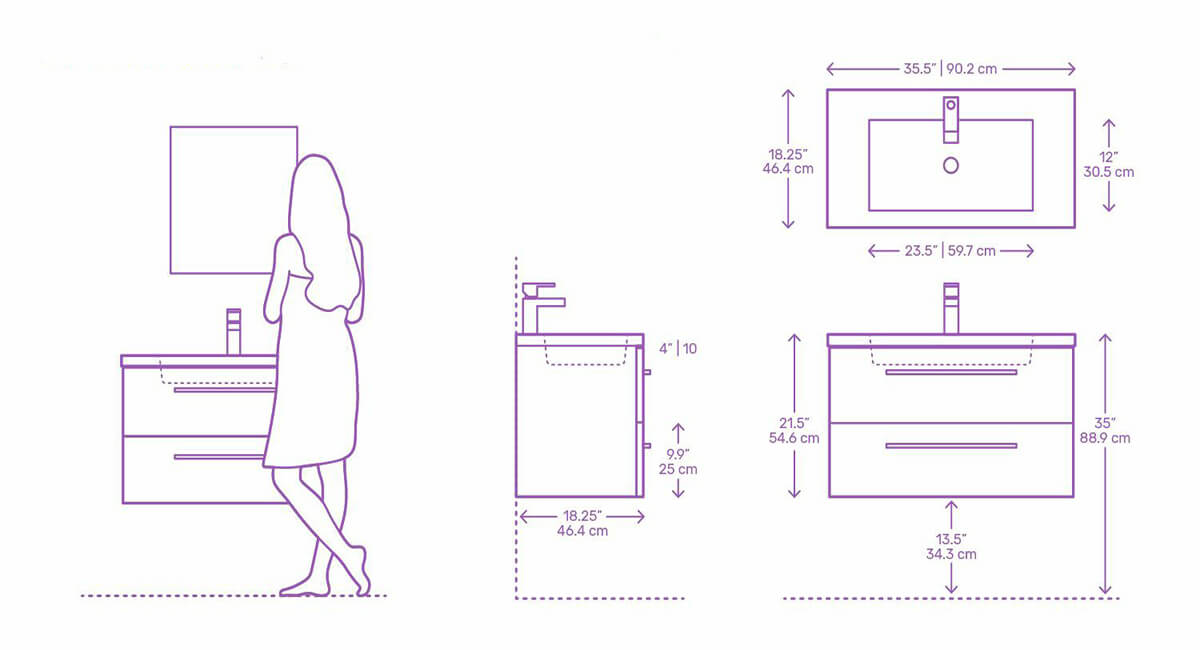Before purchasing a new bathroom vanity, there are some factors you need to consider so that you can find the right one. As a professional bathroom vanity manufacturer, we can give you reliable advice when purchasing your new vanity. Today’s guide is for those of you who don’t know how to buy a bathroom vanity. Read on to learn more.
1. Analyze the bathroom layout
First, the first step when considering purchasing a new bathroom vanity is to analyze your bathroom layout. Think about it, will your new dresser be in the same location as your old dresser? If you are considering purchasing a larger bathroom vanity, will they fit into your current bathroom floor plan? Additionally, it is important to know the location of various components in the bathroom, such as existing plumbing fixtures, windows, entrances, electrical panels, and outlets.
1) Where are the pipelines located?
The vanity connects the sink and faucets to the house’s water lines, which means any new vanity should have an open area that can fit around the water supply pipes and hoses without pinching or cutting off normal operation. In addition, the supply valve should be accessible without obstruction.
Unless you plan on rerouting the pipes, the vanity must be installed in the space near and around these pipes. This is an important factor in both the finished room’s appearance and the design budget; it’s much less expensive to use an existing layout and saves the contractor the cost of re-routing water lines. Finding a vanity that fits your current plumbing layout can also save the overall time it takes to complete your bathroom update project.
2) How much free space is there?
Look at the available space around existing pipes and in relation to other permanent features of the room. The vanity should not be positioned in a manner that impedes the flow of people to or from the room, blocks access to the bathroom, bathtub, or shower, or in any other way makes the use of the room uncomfortable. Cabinet doors and drawers should not be blocked by walls or other bathroom fixtures, including pipes. All of these obstacles should be considered when deciding which type of dresser to purchase.
(Another related post: A Step-by-Step Designing Guide for Bathroom Vanity)
2. Choose the right bathroom vanity size
Once you’ve determined your installation location, it’s time to measure the dimensions of your bathroom vanity and choose an appropriate size for a smooth installation. Bathroom vanities are available in various sizes such as 24 inches, 30 inches, 36 inches, 42 inches, 48 inches, 60 inches, and 72 inches. The 24-inch width is best for small guest bathrooms. The 30-inch is slightly larger and can be used to store some extra toiletries in a small bathroom. A 36-inch vanity, on the other hand, comes with drawers and cabinets to store basic toiletries and is suitable for most guest bathrooms. 42-inch, 48-inch, 60-inch, and 72-inch vanities provide enough space for two people in the master bathroom.
Please refer to your bathroom layout for specific sizes. But please note, be sure to measure before choosing a vanity.
3. Choose the right bathroom vanity height
In addition to size, choosing the right bathroom vanity height is also an important factor.
Master Bathroom Vanity: The master bathroom vanity should be 36 inches tall. This is also the standard height for kitchen cabinets, and the added height is usually more suitable for daily repeated use.
Guest Bathroom Vanity: For a spare or guest bathroom, look for a vanity that is 32 to 34 inches tall. It is a good compromise for bathrooms used by children and adults, adapting better to different heights.
Children’s Bathroom Vanities: Today’s children’s bathroom vanities should be approximately 30 inches in height. While a bit low for many adults, the lower counter space makes it easier to manage with kids. Look for dressers with pull-out steps in place of bottom drawers to provide power for your young children as they grow.
Although most dressers are between 33 and 36 inches tall, some have no legs. Therefore, when installing them, they will be mounted on the wall. This is a wall-mounted vanity that can be installed at the height you want.
After you determine which size and height of vanity will suit your bathroom space, you can move on to more detailed considerations such as sink design, material, style, and more.
(Another related post: Custom Bathroom Vanity: An Ultimate FAQ Guide)
4. Choose the right sink design
When choosing sinks for your bathroom vanity, you can choose from two aspects: quantity and type.
1) Number of sinks
The number of bathroom vanity sinks you choose depends on how you plan to use the space and the actual physical state of the room itself.
Single-Sink Bathroom Vanity: With only one sink available, a single-sink bathroom vanity is perfect for smaller bathrooms. They can even be placed side by side for easy storage, saving space, and adding unique character.
Double Sink Bathroom Vanity: A double sink bathroom vanity has two sinks and it can be used by two people at the same time. They usually come with two or more sinks and the entire vanity length can range from 48 inches to 80 inches.
2) Sink type
Recessed: Recessed sinks are attached directly to the bathroom vanity countertop, minimizing the mess caused by water splashes.
Undercounter: An under-counter sink is installed inside the vanity, with the edge lower than the countertop or flush with the countertop. This type of dresser is easy to clean but can be expensive.
Vessel Sink: A vessel sink is eye-catching and beautiful and sits atop a countertop that is connected to the base of a floor-standing vanity. This structure saves valuable counter space around the sink. They offer unlimited design options. For example, if pipes are exposed for some particular reason, they are designed to handle that.
Corner sink: A corner sink is a custom-made curved sink on the wall due to the special layout of the bathroom. This type of vanity is suitable for smaller bathrooms. Can maximize the rational use of space.
(Another related post: What are the Types of Bathroom Vanity?)
5. Choose the right bathroom vanity material
Bathroom vanities are made from a variety of materials, but when deciding on the type of material for your bathroom vanity, consider the following: Can natural stone withstand high humidity and humidity? Is the dresser material affordable and durable? You will make the final decision, of course.
Here are some common bathroom vanity material options.
1) Solid wood
This is the strongest material for a bathroom vanity. It brings a work of art and a timeless feel to your bathroom. The wooden material is very old. This is what most manufacturers prefer. However, one disadvantage of solid wood is that it shrinks when humidity changes. Therefore, when using a solid wood bathroom vanity, be sure to open the window for ventilation.
2) Plywood
Plywood is a more stable material used for bathroom vanities. It is ideal for those looking for a balance between price and quality. Plywood consists of many wooden exterior walls that are glued together to form stacked panels. It varies in quality, and thickness, and possesses impressive strength.
Compared to solid wood, plywood does not expand due to humidity or temperature levels.
3) Medium-density fiberboard (MDF)
MDF is a cost-effective option for those who want to stay on a budget. Composite fibers and small wood chips are held together with glue or wax in this wood. Medium density fiberboard (MDF) is commonly used in factories because it is stronger than plywood. MDF does not expand like wood.
However, when water flows over the surface, it can damage the surface if the seal is not good.
4) Polyvinyl chloride (PVC)
PVC is a low-cost cabinet material that currently leads the Australian market. What makes it unique is that it is completely waterproof and resistant to high temperatures. Therefore, PVC cabinets can last for a long time. PVC is also easier to maintain than wooden surfaces.
5) Natural stone
Natural stones include quartz, granite, and stone. This type of material is generally used as the countertop of a bathroom vanity. The advantage of a dresser made of this material is that it is easy to clean and not easily damaged.
(Another related post: Top 10 Bathroom Vanity Manufacturers in 2023)
6. Choose a bathroom vanity base design
Bathroom vanity bases are available in wall-mounted, freestanding, and corner options.
1) Wall-mounted bathroom vanity
These vanities are usually mounted on the wall. They add a super chic look to the space and make the bathroom look spacious. However, make sure the bathroom walls are strong enough to bear the weight of the vanity and sink before considering installation. If your bathroom is smaller, you might want to consider a wall-mounted vanity.
2) Freestanding bathroom vanity
These dressing tables are placed on the floor as a separate structure. They add a lot of creative edge to interior decoration, as they can easily accommodate ornate details. Their styles also vary, from modern clean lines to traditional patterns. Freestanding vanities also offer good storage capabilities, plus they are very simple to install. However, its disadvantage is that it takes up more space. If your bathroom is larger, you may want to consider a freestanding vanity.
3) Corner bathroom vanity
Such dressing tables take up little space and they fit snugly into the corners of the wall. It is the best choice for small bathrooms and people living alone.
(Another related study case: Bathroom Vanity Orders from the United States)
7. Choose the right bathroom vanity style
The key to choosing the right style for your bathroom vanity is to complement your furniture. Modern-style dressing tables and minimalist-style dressing tables are currently the two most popular styles. Polished surfaces and raw finishes are standard features of modern dressing tables. Modern bathroom vanities may have a unique minimalist design that is tailor-made to fit into a small modern space.
Many modern bathroom vanities have solid counters. It allows you to drill holes for standard sinktops. Modern vanities are attractive and can come in single or double-sink vanity designs. You can also choose a vanity that requires a custom top. Modern dressing tables not only meet the need for a beautiful appearance but also meet the need for a large storage capacity. Some modern dressing tables are equipped with large drawers and bathroom cabinets for storing bed sheets, toiletries, and other bathroom supplies.
Of course, there are many other styles to choose from. For example: hotel style, European style, luxury style, Victorian style, etc. The specific choices of these styles need to be chosen based on your preferences and how well they match other furniture.
8. Choose the right design and colors
In fact, design and color are also part of the style. However, some customers don’t like to be limited to one style, so they can customize their vanity by choosing their favorite colors and designs. For many people, the bathroom is where their day begins or ends. Therefore, a refined, attractive, and innovative appearance is what they pursue most.
Available in a variety of colors, white, grey, tan, light blue, espresso, and peachy pink are good color choices for bathroom vanities. Here’s a rundown of the trending colors this year:
1) Black
Make a bold statement with black and add drama to your bathroom. If you want to create a timeless classic look in your space, don’t think twice. A black double dresser with large cabinets on both sides looks super luxurious.
2) Gray
The ultimate neutral, gray is experiencing a renaissance. This color adds elegance and interest to a space and is widely known as the color trend of the decade. Available in Charcoal Glaze, Emma Dove Grey, French Grey, Cool Grey, Ash Blue, Sea Salt Grey, and Kelly Grey.
3) White
White is a highly sought-after hue with timeless appeal. It can prove to be the ultimate designer for your bathroom. A white vanity has clean accents and clean lines that easily fit into any design concept. Try Madison and Brooks whites, matte whites, flat whites, and more.
4) Brown
Brown creates an irresistible organic vibe in your bathroom and is a sophisticated version of rattan/wood veneer. Explore your shades from finishes like Dark Espresso, Tobacco, Restored Khaki, Natural Walnut, Mantic Brown, and Maple.
5) Silver
Bring magnanimous brilliance with silver sparkle! Unlike the usual shades, silver and many other trendy shades create a look that is both modern and distinctly urbane.
9. Other functions of bathroom vanity
A modern vanity is more than just storage space for your sink. Be sure to look for vanity cabinets that come with extra options and features designed to make daily life easier.
1) Electrical sockets
A home bathroom always needs space for sockets. From hair dryers to razors, electric toothbrushes, and cell phones, everyone has something to charge. Some vanity cabinets now offer hidden outlets in drawers and corners, safely away from the humidity and moisture of the bathroom, so that these essentials can be plugged in where they can be easily accessed.
2) Shallow Drawers
Many bathroom toiletries and accessories are smaller items that can be difficult to keep track of. Adding drawers of varying depths or sloping dividers between drawers can make hair ties, brushes, and other small items easier to reach and reduce lost space.
3) Storage pieces
From built-in metal cup holders to cross pieces, look for a vanity that creates designated space for the different clutter used in every bathroom. This could be a rack or hanger for towels, or pockets for curling irons and hair dryers.
4) Customizable technology
With advances in Bluetooth and WiFi compatibility, dressers and medicine cabinets now come equipped with speakers and charging stations for phones and smart home sound systems. Start your daily morning routine with the help of your favorite music, podcasts, and more, depending on the features you choose.
10. Budget
Assess your financial situation. How much are you going to spend on the best vanity for your bathroom? In addition to your overall budget, keep in mind that some vanity materials come with warranties and maintenance plans. However, it depends on where you buy them.
11. Conclusion
That wraps up this guide on how to buy a new bathroom vanity. This includes measurements of dimensions, sink selection, choice of materials and style, and additional features for the bathroom vanity. If you want to buy the right bathroom vanity, follow the steps above. If you have any further questions, please contact Nicemoco.













